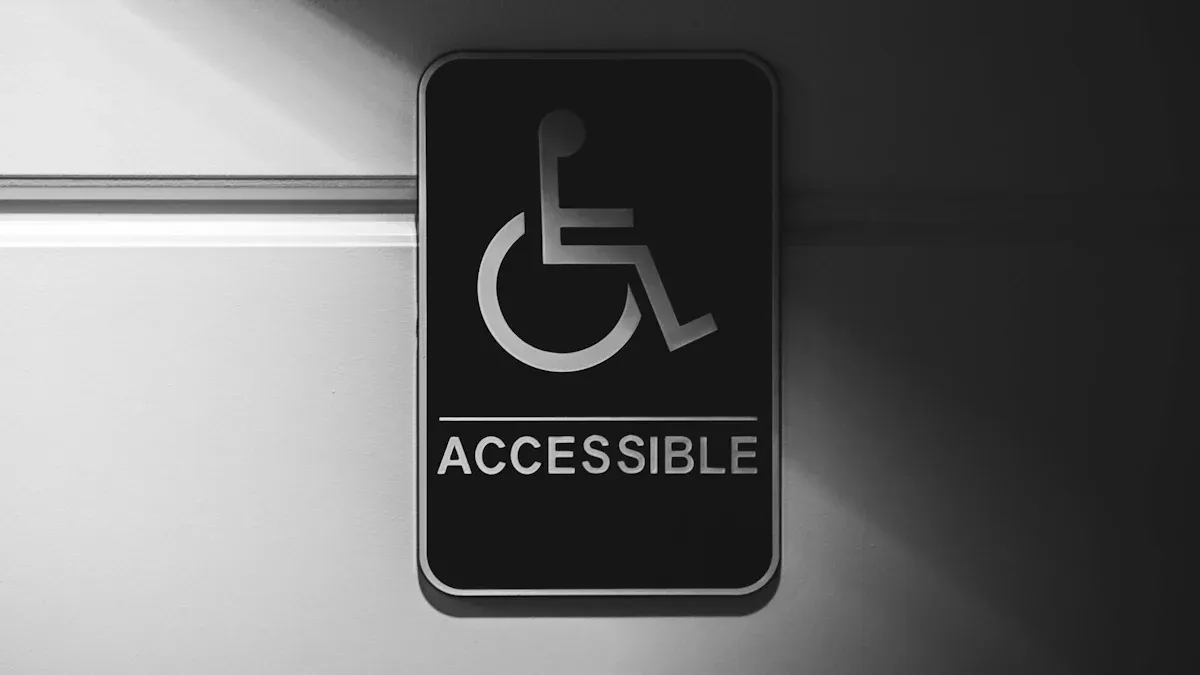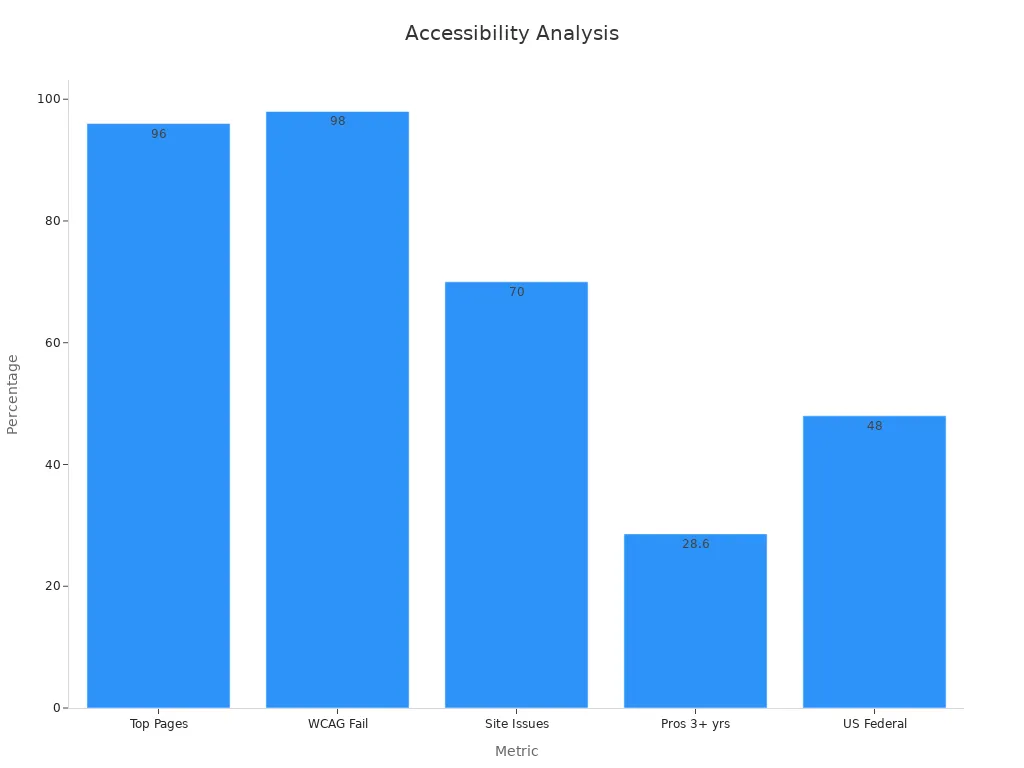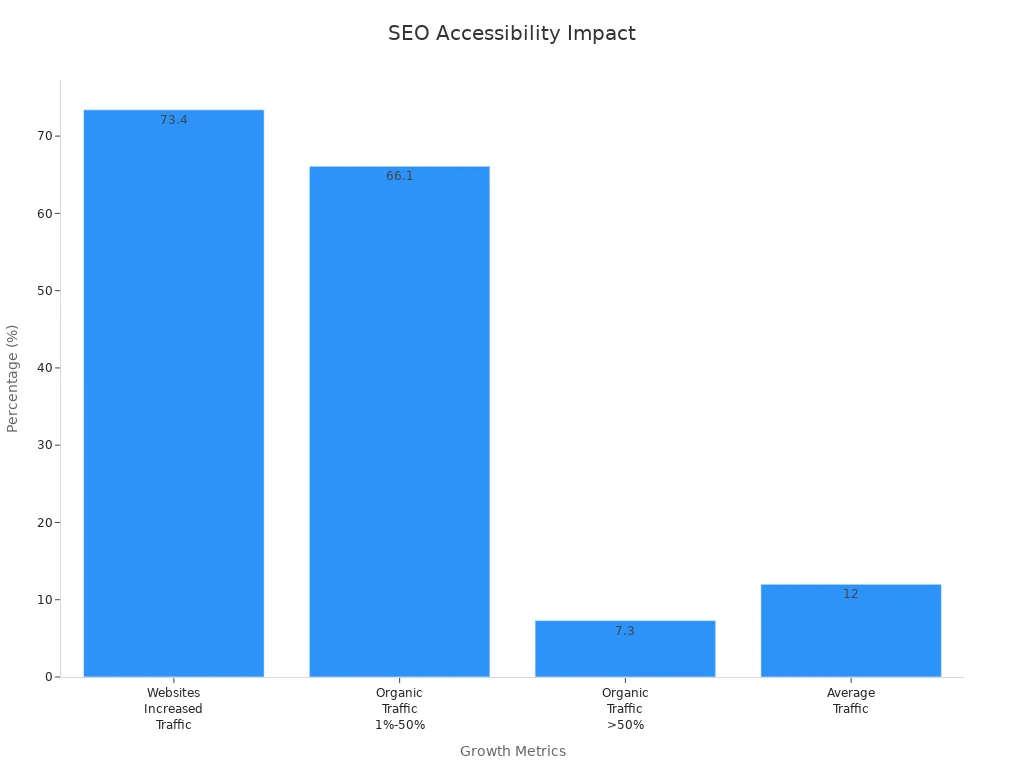How QuickCreator Supports Accessibility Standards

QuickCreator lets you make websites that follow accessibility standards today. This gives everyone, even people with disabilities, a better online experience. When you use QuickCreator, your site supports ADA compliance and is more welcoming. Sites with these accessibility tools saw 12% more visitors in three months. Around 73.4% of these sites also got more visitors from search engines. These results show that accessible design helps users and improves your website’s search ranking.
Key Takeaways
QuickCreator lets you make websites that follow key accessibility rules like ADA and WCAG. This helps everyone use your site.
QuickCreator has templates and checks that are accessible. These tools save you time. They help you avoid common accessibility errors.
QuickCreator shows you how to add alt text and other helpful features. These steps make your site better for ADA compliance. They also help you avoid legal trouble.
Making your website accessible with QuickCreator helps all visitors have a better experience. It can also boost your site traffic by up to 12%.
QuickCreator puts accessibility, SEO, and content tools together in one place. This makes it simple to manage and update your site. You do not need to know how to code.
Accessibility Standards

ADA and WCAG
You might have heard about ADA and WCAG when learning about web accessibility. The Americans with Disabilities Act (ADA) is a law in the United States. It protects people with disabilities from being treated unfairly. This law also includes websites. The Web Content Accessibility Guidelines (WCAG) are rules made by the World Wide Web Consortium (W3C). These rules help you build websites that everyone can use, no matter what they can or cannot do.
Here’s a simple table to show how they are different:
Aspect | WCAG (Web Content Accessibility Guidelines) | ADA (Americans with Disabilities Act) |
|---|---|---|
Nature | International guidelines, not a law | US federal law |
Scope | Global, covers all digital content | US, covers public accommodations including websites |
Enforcement | Voluntary, but often referenced by laws | Enforced by US Department of Justice |
Conformance Levels | Three levels: A, AA, AAA (AA is most common) | No specific levels |
Applicability | Global | US-specific |
Compliance Timeline | Ongoing updates; latest is WCAG 2.2 (2023) | Enforced since 1990 |
Tip: Many countries use WCAG as their main guide for web accessibility, even if they have their own laws.
Importance
Following accessibility standards is more than just obeying rules. You help people with disabilities use your website. This includes people who are blind, deaf, or have trouble using a mouse. When your website is accessible, more people can visit it. You also lower your risk of getting into legal trouble.
Recent studies show that most of the top one million websites are not accessible. Each homepage has over 50 accessibility mistakes on average. Most websites do not meet WCAG 2.1 standards, even though WCAG 2.2 is the newest version.

If your website is not accessible, you might lose visitors and sales. For example, US online stores lose billions of dollars each year because people with disabilities cannot use them. About 71% of users with disabilities leave a site right away if it is hard to use. By following ADA and WCAG, you make your website better for everyone and keep your business safe from lawsuits.
QuickCreator Features

Accessible Templates
You want your website to be easy for everyone to use. QuickCreator gives you a library of accessible templates. These templates use clear fonts, strong color contrast, and simple layouts. You do not need to know how to code. You can pick a template and start building right away.
Accessible templates help you avoid common mistakes. For example, each template uses headings in the right order. This helps people who use screen readers. Buttons and links have clear labels. Forms include instructions and error messages that are easy to understand. You can trust that your website will work well for people with different needs.
Tip: Start with an accessible template to save time and make your site more welcoming from the beginning.
Automated Checks
QuickCreator makes it easy to find and fix accessibility problems. The platform runs automated checks as you build your site. These checks look for missing image descriptions, low color contrast, and other issues. If QuickCreator finds a problem, you get a simple message that tells you what to fix.
You do not need to be an expert. QuickCreator guides you step by step. For example, if you forget to add alt text to an image, the system reminds you. You can add the description right away. This helps you keep your site accessible as you add new content.
Here are some ways QuickCreator supports you:
Scans your pages for missing or weak alt text.
Checks that headings and links make sense.
Reviews color choices for good contrast.
Gives you tips to improve forms and navigation.
Automated checks help you catch problems early. You can fix them before your visitors notice. This saves you time and keeps your website friendly for everyone.
QuickCreator and ADA Compliance
QuickCreator helps you meet ADA requirements every step of the way. The platform uses best practices like adding alt text to all images. This is important for people who use screen readers. It also protects you from legal trouble. Many companies have faced lawsuits because their websites did not have proper alt text.
Here is how QuickCreator supports ongoing ADA compliance:
You add images to your site. QuickCreator asks you to write clear, helpful alt text.
The system checks your alt text for quality and gives you feedback.
Regular audits review your site for missing or outdated descriptions.
You get reminders to update alt text when you change images.
QuickCreator keeps records of your changes. This helps show your efforts if you ever need to prove compliance.
Case studies show that using QuickCreator’s tools can improve both accessibility and search engine rankings. For example, an online store used descriptive alt tags on product images. This made the site easier for people with visual impairments and helped the store appear higher in search results. Another travel website improved user experience by adding helpful alt text to background images. These steps made the site more welcoming and increased organic traffic.
Note: Keeping your site accessible is not a one-time job. QuickCreator helps you stay up to date with regular checks and easy-to-use tools.
Benefits
User Experience
You want your website to be easy for everyone. Following accessibility standards helps people with disabilities use your site. Clear headings and simple navigation help all users. Better link labels make it easier to find things. When USA.gov made its site more accessible, visitors finished tasks faster. They also felt happier using the site. People using screen readers or keyboards could move around more easily. These changes also help people on phones or with slow internet.
Testing with people who are blind or deaf shows structure and navigation are important.
Making improvements keeps your site friendly for everyone.
A review of over 100 studies found accessible sites are more fun and interesting for all users. Making your site accessible gives everyone a better experience.
SEO Impact
Accessibility helps users and improves your site’s search results. Search engines like Google can read accessible sites more easily. Features like alt text and clear headings help your site show up higher. Fast loading times also help your ranking. Studies show 73.4% of sites got more visitors from search engines after making changes. On average, sites had 12% more traffic in three months.

Accessible sites keep visitors interested for longer. This tells search engines your site is helpful. Using best practices helps you avoid mistakes that hurt your ranking. Accessibility and SEO work together to help your site grow.
Easy Management
Managing an accessible site can seem hard, but QuickCreator makes it easy. You get all the tools you need in one place. Automated checks and AI analytics help you fix problems fast. Companies using QuickCreator save up to 40% on content costs. They also make dashboards 37% faster. Real-time insights help you keep your site updated without extra work.
QuickCreator combines content, SEO, and accessibility tools.
You can update your site easily, even without tech skills.
Continuous checks help you stay up to date with new rules.
Users say QuickCreator is easy and saves time. You can focus on your content and visitors, knowing your site stays accessible and works well.
You can trust QuickCreator to help you build websites that meet ADA standards. The platform gives you tools to make your site easy for everyone to use. When you use these features, you support people with disabilities and improve your site’s reach. Keep checking your site for new ways to stay accessible. Your efforts make the web better for all.
FAQ
What is web accessibility?
Web accessibility means everyone can use your website. People with disabilities can read, click, and move around your site. You help more people when you make your site accessible.
How does QuickCreator help with ADA compliance?
QuickCreator gives you tools that follow ADA rules. You get reminders to add alt text and use good color contrast. The platform checks your site for common problems and helps you fix them.
Do I need coding skills to use QuickCreator’s accessibility features?
You do not need to know how to code. QuickCreator’s templates and checks work for everyone. You can build and update your site using simple tools.
Can QuickCreator improve my site’s SEO with accessibility?
Yes! Search engines like accessible sites. When you use alt text and clear headings, your site ranks higher. You get more visitors and better results.
How often should I check my website for accessibility issues?
Check your site every time you add new content.
Use QuickCreator’s automated checks regularly.
Review your site at least once a month to stay up to date.
See Also
Mastering Fast Content Production With Quick Creator Updates
Comparing Writesonic AI And QuickCreator For Content Excellence
Stepwise Approach To Enhancing Blog Mobile User Experience

